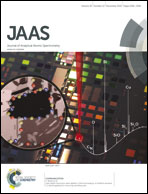Spectroscopic investigation of substrates contaminated by chemical warfare agents†
Abstract
Laser induced breakdown spectroscopy (LIBS) and Attenuated Total Reflection Fourier Transform Infrared (ATR-FTIR) spectroscopy have been evaluated for the purpose of analyzing contaminated and decontaminated substrates, such as Si wafers and different Chemical Agent Resistant Coating (CARC) paint systems. As contaminants, sarin (GB) and soman (GD) were studied as well as two simulant organophosphate compounds, trimethyl phosphate (TMP) and tributyl phosphate (TBP). First, the clean substrates were analyzed to obtain reference spectra and to reveal any interfering spectral overlap. Phosphorous lines were used to indirectly follow the occurrence of organophosphates via LIBS, which was also utilized for depth profile analysis into the substrates. Infrared absorption spectroscopy was also applied as a tool to monitor any residual contaminants. As expected, results showed that no, or below the detection limit, diffusion of the contaminants occurred into Si or the CARC paints. However, on top of and within a simple cover paint it was possible to detect P emission lines by LIBS, and ATR-FTIR revealed the presence of, e.g., C–O–P, P–F, and P![[double bond, length as m-dash]](https://www.rsc.org/images/entities/char_e001.gif) O vibrational bands, indicating GB and GD and/or breakdown products. The LIBS technique also showed promising results for monitoring diffusion processes within one paint matrix. Rinse and elution steps performed on the non-CARC paint had little effect as decontamination procedures.
O vibrational bands, indicating GB and GD and/or breakdown products. The LIBS technique also showed promising results for monitoring diffusion processes within one paint matrix. Rinse and elution steps performed on the non-CARC paint had little effect as decontamination procedures.


 Please wait while we load your content...
Please wait while we load your content...